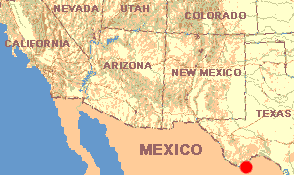 February 21, 1988 TEXAS: Brewster County
February 21, 1988 TEXAS: Brewster CountyHiking into the foothills just south of the Chisos's highest peaks, elevation averaging maybe 4500 feet.
 February 21, 1988 TEXAS: Brewster County
February 21, 1988 TEXAS: Brewster CountyNow I walk into the foothills just south of the Chisos's highest peaks.
On the first morning of this walk I find a Torrey Yucca, Yucca torreyi, about eight feet tall, with stiff, bayonet-like, green leaves atop a rough stem mostly covered with down-hanging dead leaves... and it's flowering. Its two-foot high inflorescence of two-inch long, cream-colored flowers is abuzz with honeybees and flies. Thinking I recall that yucca flowers are edible, I pop a blossom into my mouth. Like rose-scented talc, it's bitter and perfumy. No, I'll not eat another, at least not raw.
At noon, with a white flower one inch high atop an egg-shaped body two inches high, and bristling with short, thin spines, I find our first blossoming cactus. The book says that within its distribution it's the earliest cactus to bloom; its name is simply Early-bloomer, Echinocactus intertextus..
At Dodson Spring I stand beside a pool of much needed water; covered with green algae. It's a zoo of five-inch long horsehair worms not much thicker than a real horse hair. I can't imagine how such a slender worm could possess enough musculature to squirm as vigorously as it does. Nearby a backswimmer jerkily swims upside down, like a disoriented aquatic cockroach. Sometimes it rests at the water's surface, replenishing its air supply by poking the tip of its abdomen above the water's surface. Dipping water into my hand I see pinhead-sized copepods, water-fleas, and myriad glowing specks of other forms of microscopic life. While I gratefully fill my canteens from this spring an amber-colored vespid wasp lands at the pool's edge and inserts its mouthparts into the green scum there. A brilliant glisten forms where its mouthparts touch the water.
At 3 PM at about 4400 feet I spook the first White-tail Deer seen since Big Bend. At Amistad white-tails were abundant while mule deer never were seen. Here the common deer of the lowlands is the mule deer, while white-tails live only at the higher, moister elevations. According to Big Bend's naturalists, these high-elevation white-tails constitute a relict population left from the Ice Age when Big Bend's climate was cooler and moister. Apparently Big Bend's white-tails constitute a genetically isolated race smaller in stature than typical white-tail deer, and endemic to the Chisos and a few nearby ranges. This race is referred to as the Sierra del Carmen White-tail Deer. At this time in history the climate here seems to be warming. Gradually the lowland-living mule deer seem to be encroaching on the white-tail's mountain domain.
At 9 AM I'm in Fresno Creek as it dips into a ravine so deep and narrow that its almost-vertical walls above me cause claustrophobic feelings. However, in the microhabitat consisting of limestone walls in the ravine's bottom, protected from heavy sunlight and dry winds, a white-blossomed Basket Anemone (or Ten-petaled, Anemone heterophylla) makes its home. It's as green and fragile-looking as any Eastern wildflower.
Farther down the ever-deepening chasm a single yellow-blossomed Fremont's Monkey-flower, Mimulus glabratus, and several blue-flowered Berlandier's Lobelias, Lobelia berlandierii, are blossoming.
At 10 AM, still in Fresno Creek's too- narrow gorge, I'm surprised to find a tiny woods of thirty-foot tall cottonwoods. Beneath them lies a thick, dry carpet of brown leaves, so crisp and untattered that they could have fallen very recently. Hearing leaves crunching beneath me and smelling the disintegrating leaves' dust, I'm filled with early-November feelings. But when I see that the tree's branches bear newly expanded, 2-inch wide, yellow-green leaves that glow radiantly, almost wetly, in the sunlight, and that nearby dozens of twenty-inch tall, blue-flowered Berlandier's Lobelias are blossoming, early-May feelings flood into my early-November head-set. How strange to have these distinct season-feelings at the same time.
At 1 PM finally, abruptly and liberatingly, Fresno Creek emerges from its dank, narrow gorge and begins meandering across a broad, flat plain. Here the creek develops a wide, boulder-strewed bed as sun-scorched, dry and windy as was lower Tornillo Creek's. In this mind-numbing, too-bright landscape I spot a tiny creature, a kind of hyperactive mammal sprinting from one rock to the other. It's the Whitetail Antelope Squirrel, Ammospermophilus leucurus, and it seems not only to be at home in this sun-scorched landscape but absolutely thrilled to be here. Patterned like an Eastern Chipmunk, it carries its miniature tail above its back in the manner of a Gray Squirrel. My mammal field guide says that this species does not have to drink water! It survives on moisture in its food, which includes insects.
2:00 PM. All day long... sunlight, dust, wind, now 80º, feeling much hotter in the sun, much cooler in the shade... A large, blackish butterfly, maybe a swallowtail, rushes past, carried in the wind. A poem in Haiku style materializes in my mind and I write it down:
At 8 o'clock this morning a Mockingbird, Black-throated Sparrow, Loggerhead Shrike and a Cactus Wren all sing spring songs in the cool morning air. A coyote runs down a dry arroyo. I'll be back at Henry at K-Bar before the sun gets too high.